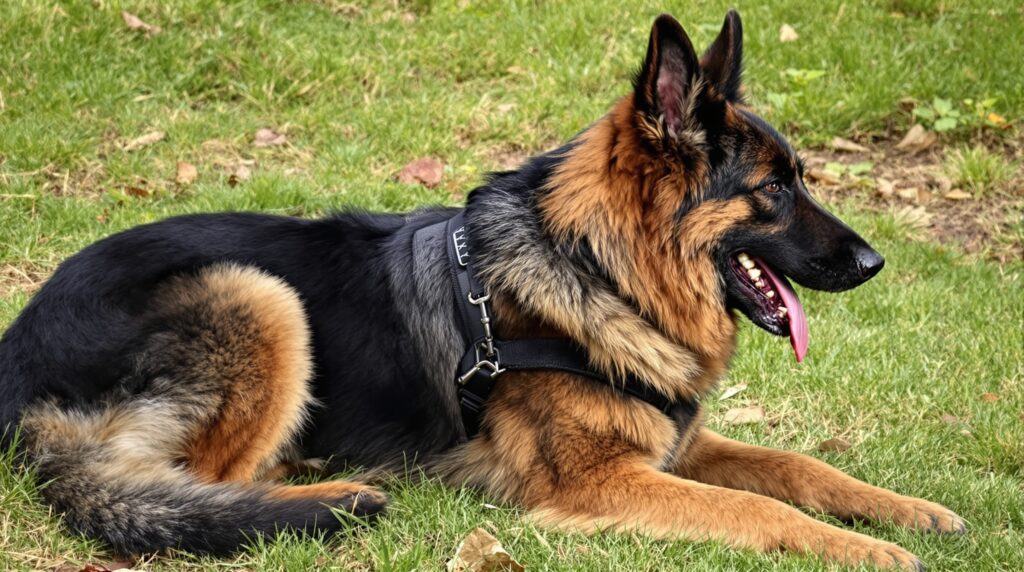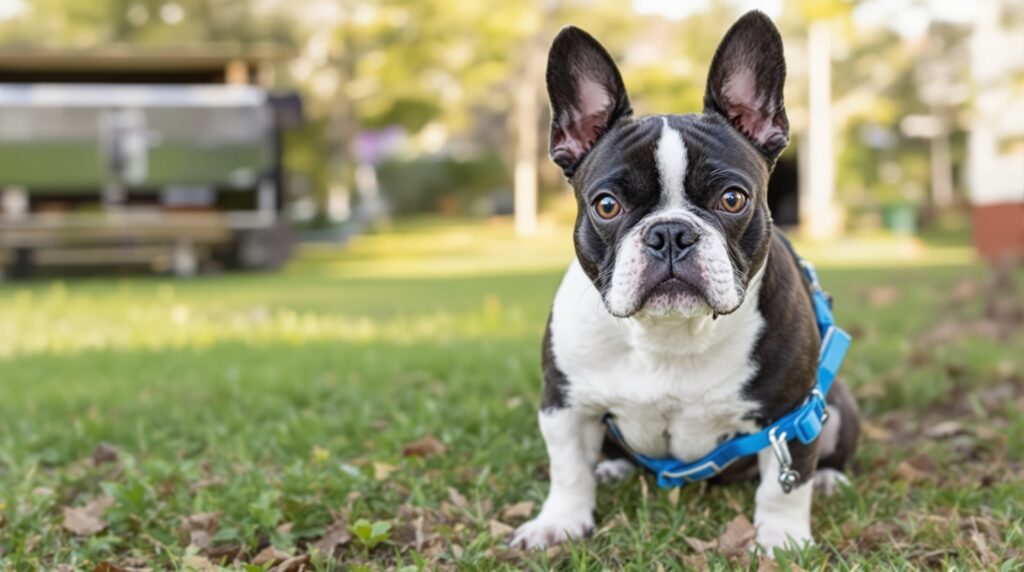Training a German Shepherd isn’t just about “sit” and “stay.” These dogs are smart—sometimes too smart for their own good—and they need mental workouts just as much as physical ones.
If you keep their minds busy, training actually gets easier and a lot more fun for both of you.
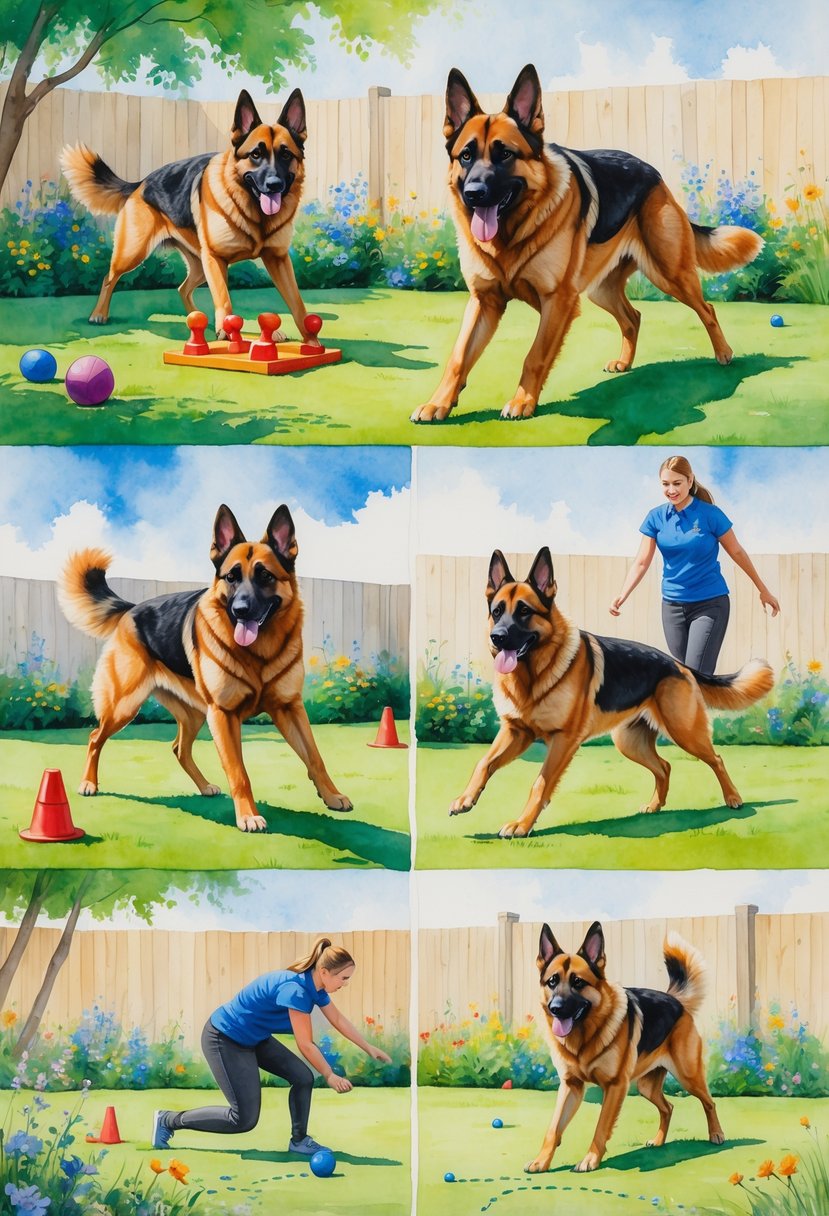
You can turn everyday stuff into brain games that challenge their problem-solving and obedience. These games also help cut down on bad habits.
Puzzle toys, scent work, and creative training give your German Shepherd the structure and stimulation they crave. With the right approach, you’ll see better focus during training and a calmer, more balanced dog at home.
Key Takeaways
- Mental stimulation is just as important as physical exercise.
- Engaging the mind makes training smoother and more effective.
- Simple daily activities can double as brain-boosting exercises.
Why Mental Stimulation Is Essential for German Shepherds
German Shepherds need more than a jog around the block or a quick game of fetch. Their sharp minds need activities that challenge memory, focus, and problem-solving.
If they don’t get these outlets, training gets a lot tougher, and you might start seeing unwanted behaviors.
Understanding German Shepherd Intelligence
German Shepherds are among the smartest dog breeds out there. They pick up new commands quickly—sometimes after just a few tries—and they remember them, too.
That’s why they’re so good at jobs like search and rescue, police work, and service dog gigs.
Your dog wants tasks that go beyond just running around. They want to think, solve problems, and work with you.
Give them puzzles, advanced obedience, or scent games, and you’re tapping into what they were bred to do.
A smart dog without mental challenges? They get restless. Keeping their brain active helps build skills and strengthens your bond through shared learning.
Benefits of Mental Stimulation in Dog Training
Add mental exercises to your training, and your German Shepherd learns faster and stays more focused.
Puzzle feeders, memory games, or advanced command sequences really improve their attention span and impulse control.
This makes training feel easier. Teaching delayed responses or hand-signal commands helps your dog concentrate even when there are distractions.
Skills like these carry over to real life—walks, parks, meeting guests, you name it.
Mental stimulation also builds confidence. When your dog solves a problem, they feel good about it, and that motivates them to keep learning.
Preventing Destructive Behaviors
A bored German Shepherd will find their own “job”—chewing the couch, digging up the yard, barking at nothing. Not exactly what you want.
These behaviors usually mean they’re not getting enough mental or physical outlets.
Give your dog structured brain work, and you’ll see less frustration and restlessness.
Simple changes—rotating puzzle toys, hiding treats, or setting up a mini obstacle course—keep their mind busy and happy.
Think of mental stimulation as prevention. Instead of fixing bad habits later, you’re giving your German Shepherd healthy ways to use their energy and intelligence every single day.
How Mental Stimulation Supports Effective Dog Training
Mental stimulation helps your German Shepherd stay engaged and learn faster. It also helps them avoid destructive habits.
A busy mind leads to more productive training sessions for both you and your dog.
Building Focus and Obedience
German Shepherds love to learn, but they’ll check out if training gets repetitive.
Mental exercises like puzzle toys, scent games, or new commands give them a challenge and sharpen their attention.
Mix in problem-solving activities, and your dog learns to concentrate for longer stretches.
This focus really pays off in obedience training. Following cues like sit, stay, or come gets easier.
Try a quick brain game before formal training to “warm up” their mind. Hiding treats around the room builds scenting skills and gets them ready to listen.
Little steps like these help your dog stay alert and responsive during lessons.
Reducing Hyperactivity and Anxiety
If your German Shepherd doesn’t get enough mental exercise, you’ll probably see barking, chewing, or pacing.
Redirect that energy with structured activities.
Games that make them think—like learning a new trick or solving a food puzzle—can calm an overexcited dog.
Mental work is tiring, and a dog who’s worked their brain is usually more relaxed.
Adding variety also helps reduce anxiety. Letting your dog explore new environments, textures, or safe social situations builds confidence.
When they feel secure and stimulated, nervous habits fade away.
Strengthening the Human-Dog Bond
Training isn’t just about commands—it’s about trust.
Mental stimulation gives you more chances to interact with your German Shepherd in ways that matter.
Guide them through a puzzle or reward them for figuring something out, and you’re building positive associations with learning.
This makes your dog more willing to follow your lead next time.
Simple activities like teaching a new trick or playing a scent game also strengthen communication.
Your dog learns to look to you for direction, and you get a better sense of how they think. That teamwork builds a bond that supports all your training.
Top 10 Mental Stimulation Exercises for German Shepherds
German Shepherds need activities that challenge their brains and keep their energy going in the right direction.
Games and training methods that mix play with learning help you build a stronger bond and cut down on unwanted behaviors.
Puzzle Toys and Treat Dispensers
Puzzle toys give your German Shepherd a job to do, and they get food as a reward. These toys make your dog think, push, paw, or roll things around to get the treats out.
They’re great for mealtime because they slow down eating and make your dog work for their food.
Start simple—maybe a toy where they slide or lift pieces. As your dog gets the hang of it, try more complex puzzles with extra steps.
Rotate different puzzles so your dog doesn’t get bored.
DIY options are awesome, too. Toss kibble in a muffin tin and cover each spot with a tennis ball. Cheap, easy, and it keeps your dog busy.
Tip: Always keep an eye on your dog at first to make sure they don’t chew up or break the toy.
Scent Work and Nose Games
German Shepherds have amazing noses, and nose games let them use that skill.
Hide treats around your house or yard and encourage your dog to sniff them out.
Start simple—let your dog watch you hide the treat. Then make it harder by hiding it out of sight.
You can use favorite toys instead of food if you want to mix it up. This keeps the game from getting stale.
For a challenge, introduce specific scents like cloves or essential oils, and teach your dog to alert you when they find the target.
Scent work builds patience and focus. Plus, it gives your dog a mental workout without needing a ton of space or fancy gear.
Simple Scent Game Setup:
- Hide 3 small containers.
- Put a treat in one.
- Let your dog find the right one.
Interactive Obedience Drills
Obedience training doesn’t have to be basic or boring.
German Shepherds thrive when you add variety and complexity.
Try combining commands into short sequences: “sit, down, stand” in a row keeps your dog thinking.
Switch it up—move from verbal commands to hand signals. This makes your dog really pay attention to your body language.
Delayed response training is another great drill. Your dog has to wait before doing the command, which helps with impulse control.
Keep sessions short and upbeat. Use treats or play as rewards.
Practice regularly, and you’ll see stronger obedience and a more engaged dog.
Hide and Seek
Hide and seek is simple but surprisingly effective. You can hide yourself, a family member, or your dog’s favorite toy.
Call your dog to find the hidden person or thing, and give them a reward when they succeed.
This game is great for recall skills—your dog learns to come even when they’re distracted.
It also teaches problem-solving as they search around.
Start easy—hide in plain sight. Then get trickier with spots behind doors or furniture.
Toss toys or treats under blankets or boxes for a new twist.
Benefits of Hide and Seek:
- Boosts recall
- Builds confidence
- Gives both mental and physical activity
Advanced Brain Games for Ongoing Challenge

Mental stimulation works best when you keep raising the bar. Add variety, structure, and new problem-solving elements, and your German Shepherd will stay engaged and ready to learn.
The Professor Akira Method
This method is all about teaching your dog to recognize and respond to specific objects or cues.
Start by naming one toy—say, “ball”—and reward your dog for picking it from a small group.
As they get better, add more items and tougher commands.
German Shepherds love this kind of challenge because it taps into their working-dog instincts.
Switch up the game by rotating objects, using different textures, or even introducing colors.
A simple setup might look like this:
| Cue Word | Object | Reward Type |
|---|---|---|
| Ball | Tennis ball | Treat |
| Rope | Tug toy | Play session |
| Duck | Plush toy | Praise |
This exercise builds word-object recognition, sharpens memory, and improves focus. Plus, it strengthens your bond through clear communication.
Obstacle and Agility Courses
Agility training isn’t just about exercise—it’s a brain workout, too.
When you guide your dog through tunnels, weave poles, and jumps, they have to process commands and adjust their movements at the same time.
No need for a fancy course. Grab some chairs, broomsticks, or cardboard boxes and set up a basic course in your yard.
Keep sessions short at first so your dog doesn’t get overwhelmed.
Introduce one obstacle at a time. Once your dog nails it, link two or three together.
Use clear cues like “over” or “through” and reward right after completion.
Agility work boosts coordination, strengthens obedience, and keeps your dog mentally sharp. German Shepherds especially love it—they’re athletic and quick learners.
Learning New Tricks
Teaching new tricks isn’t just for show—it’s a real mental challenge.
Start small with behaviors like “spin” or “bow.” Later, try advanced ones like “put toys away” or “open a door with a rope.”
Break each trick into steps:
- Lure with a treat.
- Mark the right move.
- Reward and repeat.
Go step by step so your dog doesn’t get frustrated. Mix things up—practice in different rooms or outdoors so your dog learns to generalize.
German Shepherds like tasks that feel useful. Tricks that involve carrying things, helping with chores, or following multi-step commands give them both mental and practical challenges.
Add new tricks regularly, and you’ll keep training fresh and rewarding for both of you.
Incorporating Mental Stimulation into Daily Routines
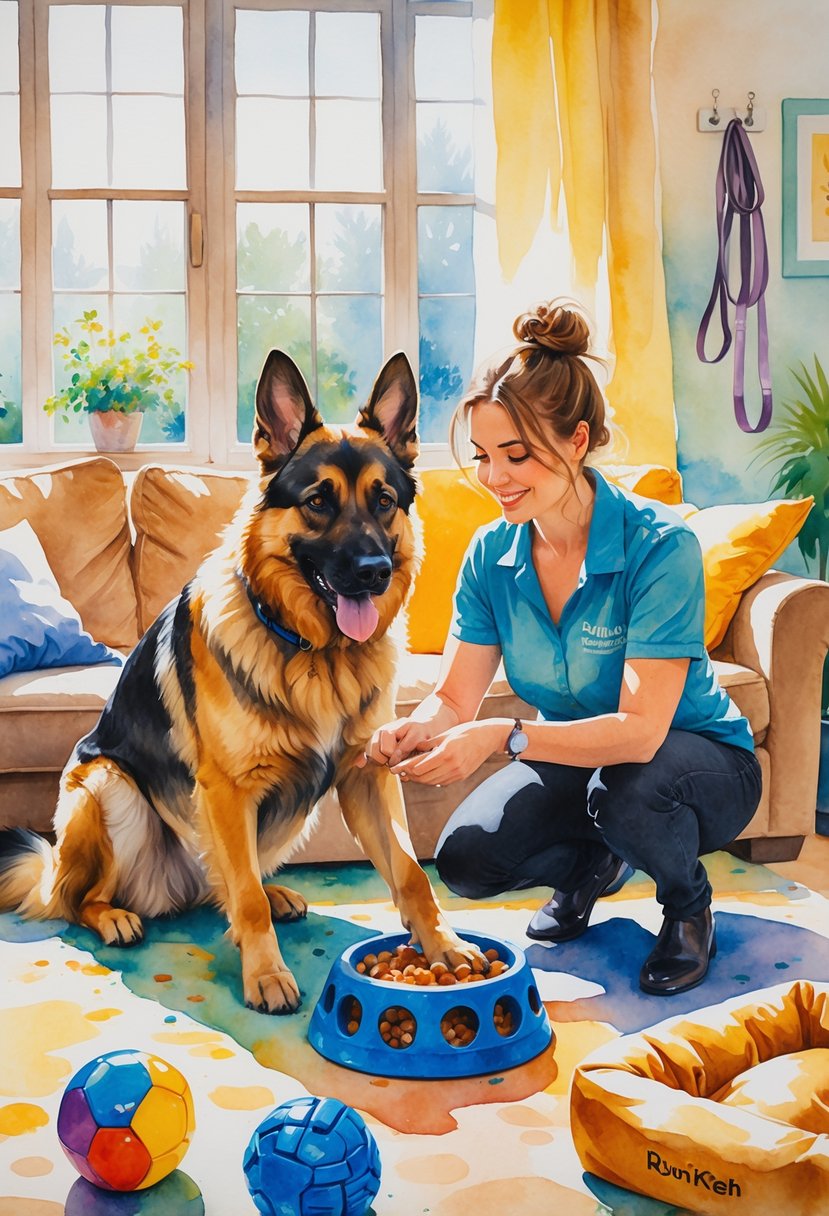
You can make training easier by sprinkling small mental challenges into your dog’s usual day. Try quick practice sessions, mix exercise with brain work, and get creative with household items as enrichment tools. That’ll help your German Shepherd stay focused and less likely to get bored.
Short and Frequent Training Sessions
German Shepherds pick things up best when training sessions stay short. Aim for 5–10 minutes at a time, a few times a day.
That way, your dog stays interested and doesn’t get overwhelmed. Focus on just one or two commands per session.
Maybe in the morning, you practice sit and stay, then down and come later on. Small bursts of repetition help your dog remember.
Switch up rewards—use treats, toys, or just a happy “good dog!” Mixing it up keeps things exciting.
Try to end on a win, so your dog feels good and actually looks forward to next time.
Combining Physical and Mental Exercise
German Shepherds need both body and mind challenges. You can blend these to save time and get better results.
Slip obedience commands into your walks. Ask for a sit at a crosswalk or a heel when you pass distractions.
Suddenly, a regular walk becomes a training session. Fetch can turn into a brain game, too.
Before throwing the ball, ask your dog to down or wait. It adds structure and teaches patience.
Agility courses or scent games in the yard are awesome for both movement and focus. These activities burn off energy and sharpen problem-solving skills.
Using Everyday Objects for Enrichment
You really don’t need fancy gear to challenge your dog’s mind. Tons of everyday items work as enrichment tools.
A muffin tin with tennis balls covering treats in each cup turns into a simple puzzle. Your dog has to move the balls to get the food.
Cardboard boxes make great scent games—just hide some kibble inside. Rotate toys and objects often to keep things interesting.
Even a towel can become a brain game if you roll treats inside and let your dog figure out how to unroll it.
Simple stuff like this turns ordinary moments into learning opportunities, and it doesn’t cost extra.
Tips for Success and Common Mistakes to Avoid
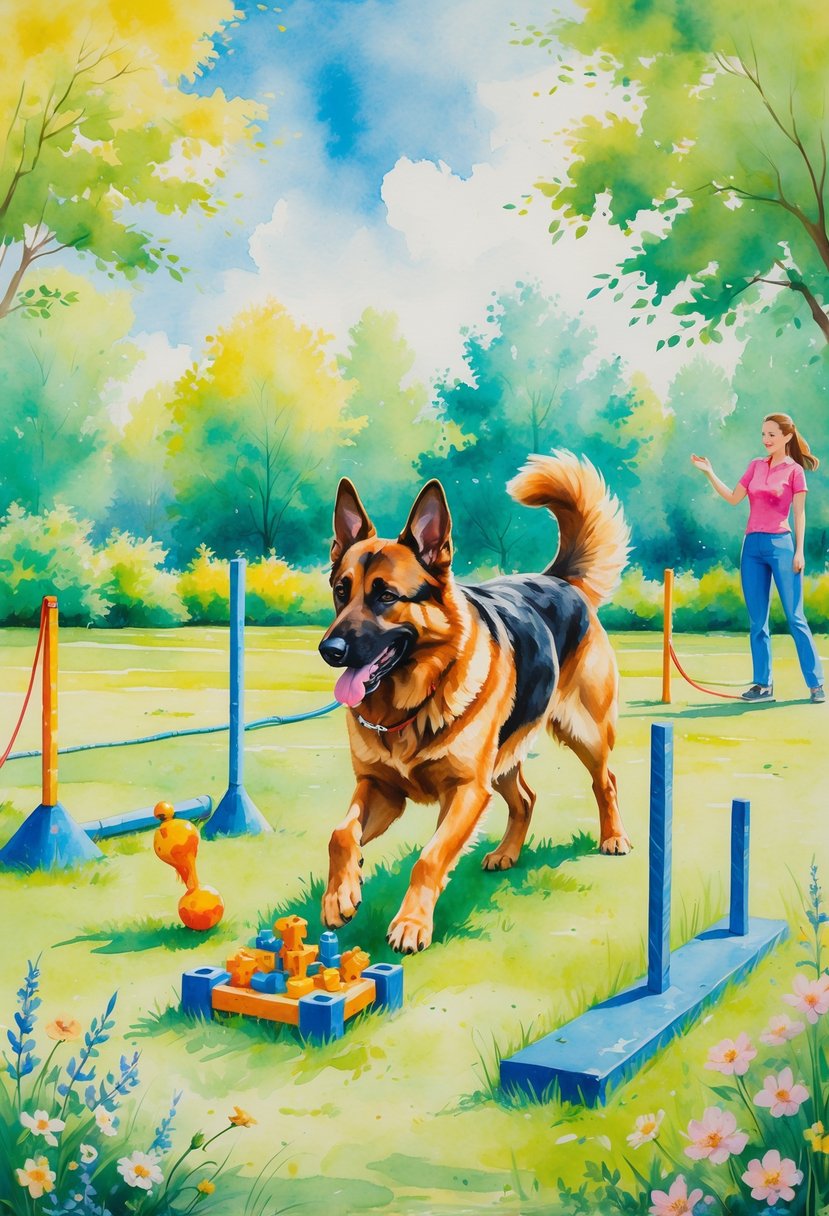
Training your German Shepherd goes more smoothly when you match activities to their age. Keep sessions balanced and use rewards wisely.
Paying attention to these details can really help prevent frustration for both you and your dog.
Choosing Age-Appropriate Activities
Your German Shepherd puppy’s needs are different from an adult or senior dog’s. Puppies do well with short, simple games like “find the treat” or gentle puzzle toys.
These games challenge their minds without stressing their joints. Adult dogs can try more advanced stuff—agility, scent tracking, or learning commands with a few steps.
That keeps their brains sharp and gives them a job to focus on. For older dogs, ease off the physical stuff but keep their minds busy.
Slow-paced games, food puzzles, or sniffing walks work great. Even learning a new trick at a relaxed pace helps.
Quick guide by age:
| Age Group | Best Activities | Avoid |
|---|---|---|
| Puppy (8-18 mo) | Short games, basic commands, light puzzles | Long runs, high-impact jumps |
| Adult (2-7 yr) | Agility, scent work, advanced obedience | Repetitive, boring drills |
| Senior (8+ yr) | Low-impact puzzles, gentle training | Overly strenuous or fast-paced activities |
Avoiding Overstimulation
German Shepherds are eager learners, but too much at once can overwhelm them. If your dog starts pacing, barking, or ignoring commands, they might just need a break.
Keep mental exercises short—5 to 10 minutes for puppies, 15 to 20 for adults. Then let them rest.
Multiple short sessions work better than one long one. Mix in calm activities, like chewing a safe toy or practicing a simple “sit.”
That balance keeps training fun and helps prevent burnout.
Consistency and Positive Reinforcement
Your German Shepherd learns best when you stay consistent. Use the same cues for each command.
Try not to switch up your approach too often. That way, your dog connects the word, action, and reward much faster.
Positive reinforcement usually beats punishment by a mile. Give a small treat, some praise, or a bit of playtime right after your dog does the right thing.
This makes the connection clear and builds motivation. Be patient, and celebrate the little wins—even just a few seconds of focus is worth noticing.

